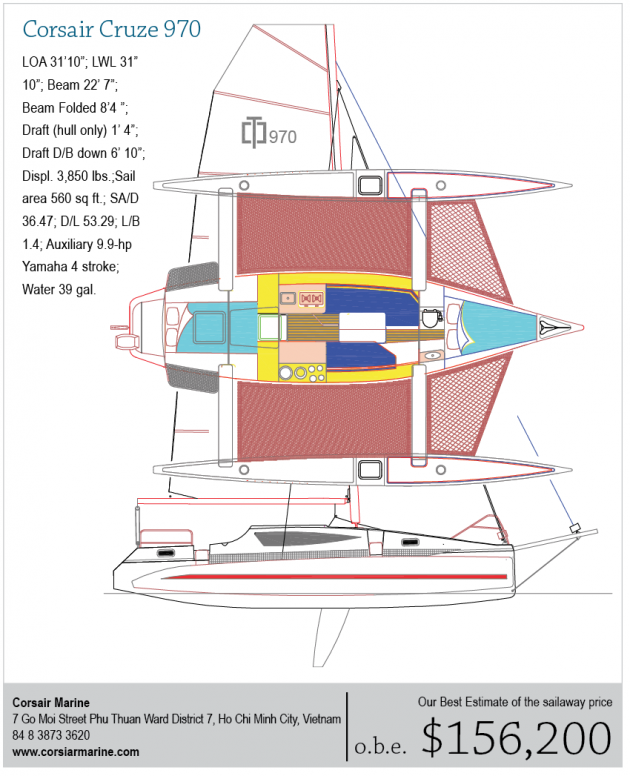Corsair Cruze 970
Sport trimaran
 If I were in the market for a multihull I could race and cruise, I'd be looking at this new Corsair Marine trimaran. I have had the benefit of sailing with my buddy Doug on his Corsair 27 with the turbo rig, and I really like sailing his boat. It's hard not to have fun when you are doing an effortless 14 knots at a 5-degree heel angle.
If I were in the market for a multihull I could race and cruise, I'd be looking at this new Corsair Marine trimaran. I have had the benefit of sailing with my buddy Doug on his Corsair 27 with the turbo rig, and I really like sailing his boat. It's hard not to have fun when you are doing an effortless 14 knots at a 5-degree heel angle.
The new 31-foot 10-inch model replaces the Corsair 31. Corsair sold 303 of those models, and I would call that a success by any criteria. The new 970 is roomier with more focus on comfort without sacrificing performance.
The center hull of this trimaran shows very flat rocker through the middle of the hull. By "rocker," I am referring to the fore-and-aft curvature of the hull's centerline. This flat fore-and-aft rocker kicks up in the ends. The transom tip is just above the DWL with the boat at rest.
The D/L for this boat is 53.29 with a displacement of only 3,850 pounds, and that should make people who intend to trailer their trimarans happy. With the wide, folding amas in place the L/B is 1.4.
These amas have more volume than the 31-foot model for better stability and comfort.
Draft with the daggerboard down is 6 feet 10 inches, and draft with the board and rudder retracted is only 16 inches. The main hull uses a chined, margarita glass-shaped section to maintain a narrow BWL while providing volume where needed for accommodations. For the heck of it, I calculated the L/B of one of the amas, and it came in at 13.23. That is very narrow.
While you could use all that beam for accommodations, it won't work with folding amas, and it won't work if you want a light boat that sails fast. So the price you pay for this speed is seen in the accommodation plan. Even with the flared-out topsides, the L/B of the main hull is 4.11 so we are dealing with a narrow boat. But you get double berths in the ends with a small head forward that spans the beam.
You access the aft berth through the cockpit. The galley area is small but very workable. The daggerboard trunk impacts the main cabin, and to get by it the starboard settee is cut short. I think four people would be a crowd for dinner at this table. The holding tank capacity is only 13 gallons, and I can think of some cruising grounds where the that could pose a problem. But you can't have low hull volume and big tanks.
I don't think you would spend much time under power in this tri. The SA/D is 36.47, and that's a lot of sail power per pound, easily enough to give you very good light air boat speed. The mast is a rotating wing. A carbon fiber bowsprit allows you to fly either a 448-square-foot screecher or an 893-square-foot chute. That is enough off-the-wind sail area to provide for some very exciting sailing. For some comparison, the 893-square-foot spinnaker is bigger than the entire rig of the Cal 40.
The cockpit area on this type of tri is tight. That's what you get with a narrow main hull. But it's not fair to compare this cockpit to that of a monohull cockpit. When you are sailing you can sit anywhere you like on the windward trampoline so true "deck space" is enormous.
The mainsheet attaches to a traveler on the stern, and there is a deep swim platform aft. I like the look of this boat. The deck has been sculpted to provide headroom where it is needed, while keeping the overall profile low.
On a typical summer day I'll see my buddy Doug leave his mooring on the next beach and hoist the sails on his Corsair. He almost always sails alone. He'll scream out to the middle of the bay then tack and make a beeline for my beach, usually aiming right at my mooring. I'll sit there with my hopes up that he'll go head to wind at my shack and wait for me to row out for an afternoon's sail. Sometimes I get lucky. Sometimes Doug just jibes and races off down the bay waving to me as he hoists his chute. Doug really likes his boat.

Comments